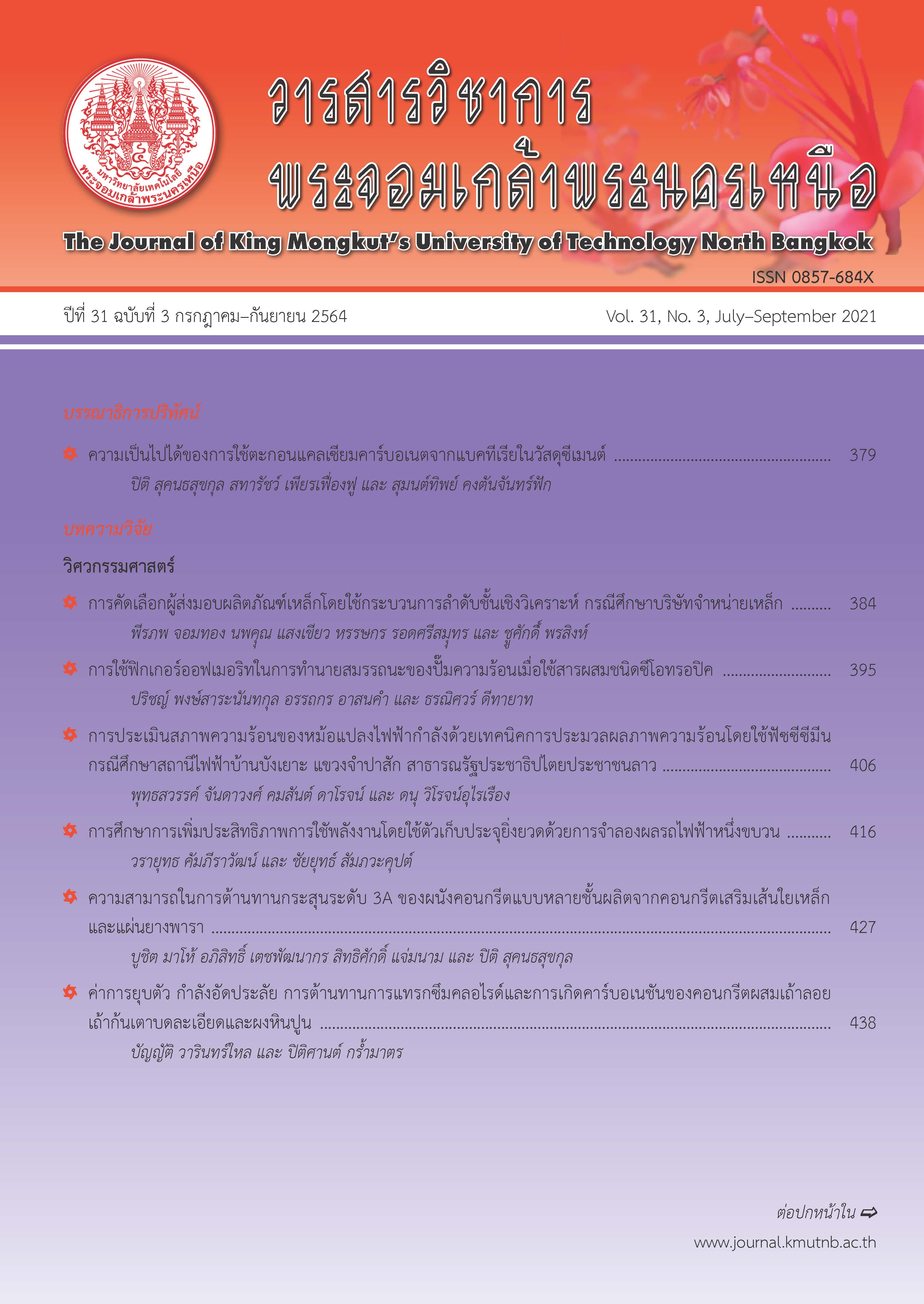ความสามารถในการต้านทานกระสุนระดับ 3A ของผนังคอนกรีตแบบหลายชั้นผลิตจากคอนกรีตเสริมเส้นใยเหล็กและแผ่นยางพารา
Main Article Content
บทคัดย่อ
งานวิจัยนี้เป็นการศึกษาความสามารถในการต้านทานแรงกระแทกของผนังคอนกรีตกันกระสุนแบบหลายชั้นที่ทำจากคอนกรีตเสริมเส้นใยเหล็ก (FRC) และแผ่นยางพารา (R) ภายใต้การต้านทานการยิงด้วยกระสุนระดับ 3A (.44 Magnum Semi Jacketed Hollow Point) ตามมาตรฐาน National Institute of Justice (NIJ) การทดลองแบ่งเป็น 2 ส่วน คือ ส่วนที่ 1 การทดสอบความสามารถในการดูดซับพลังงานจลน์จากกระสุนของวัสดุแต่ละชนิด ได้แก่ แผ่นยางพารา แผ่นโฟม ที่ความหนาแตกต่างกัน และคอนกรีตเสริมเส้นใยเหล็กที่แปรผันปริมาณเส้นใยและชนิดของเส้นใย ส่วนที่ 2 ได้นำข้อมูลจากส่วนแรกมาใช้ในการออกแบบผนังกันกระสุนแบบหลายชั้น และเพื่อเป็นการตรวจสอบความถูกต้องในการออกแบบ ผนังถูกออกแบบให้มีความสามารถในการดูดซับพลังงานจลน์รวมแตกต่างกันด้วยการแปรผันองค์ประกอบของผนัง เช่น ประเภทของวัสดุหรือความหนา ผลการทดลองพบว่าความสามารถในการดูดซับพลังงานจลน์ของวัสดุแต่ละชนิดแตกต่างกันตามความหนา ปริมาณเส้นใย และชนิดของเส้นใย ซึ่งเมื่อนำมาออกแบบเป็นผนังแบบหลายชั้นที่มีความสามารถในการดูดซับพลังงานแตกต่างกัน พบความเสียหาย 3 รูปแบบ ได้แก่ 1) กระสุนทะลุผ่าน 2) กระสุนไม่ทะลุผ่าน ฝังอยู่ในผนัง และเกิดการกะเทาะด้านหลัง และ 3) กระสุนไม่ทะลุผ่าน ฝังอยู่ในผนัง และไม่เกิดการกะเทาะด้านหลัง โดยค่าระดับพลังงานจลน์รวมที่ทำให้เกิดความเสียหายในรูปแบบที่ 3 มีค่าเท่ากับ 3172 จูล
Article Details
บทความที่ลงตีพิมพ์เป็นข้อคิดเห็นของผู้เขียนเท่านั้น
ผู้เขียนจะต้องเป็นผู้รับผิดชอบต่อผลทางกฎหมายใดๆ ที่อาจเกิดขึ้นจากบทความนั้น
เอกสารอ้างอิง
[2] P. Sukontasukkul, S. Mindess, and N. Banthia, “Penetration resistance of hybrid fibre reinforced concrete under low velocity impact loading,” presented at Annual Conference of the Canadian Society for Civil Engineering, Montreal, Quebec, Canada, 2002.
[3] M. Nili, A.H. Ghorbankhani, A. AlaviNia, and M. Zolfaghari, “Assessing the impact strength of steel fibre-reinforced concrete under quasi-static and high velocity dynamic impacts,” Construction and Building Materials, vol. 107, pp. 264–271, 2016.
[4] R. Sovjak, T. Vavriník, J. Zatloukal, P. Maca, T. Micunek, and M. Frydrýn, “Resistance of slim UHPFRC targets to projectile impact using in-service bullets,” International Journal of Impact Engineering, vol. 76, pp. 166–177, 2015.
[5] S. Kravanja, R. Sovják, P. Konrád, and J. Zatloukal, “Penetration resistance of semi-infinite UHPFRC targets with various fiber volume fractions against projectile impact,” Procedia Engineering, vol. 193, pp. 112–119, 2017.
[6] A. T. Noaman, B. H. Abu Bakar, and H. M. Akil., “The effect of combination between crumb rubber and steel fiber on impact energy of concrete beams,” Procedia Engineering, vol. 125, pp. 825–831, 2015.
[7] P. Sukontasukkul, S. Jamnam, K. Rodsin, and N. Banthia, “Use of rubberized concrete as a cushion layer in bulletproof fiber reinforced concrete panels,” Construction and Building Materials, vol. 41, pp. 801–811, 2013.
[8] S. Jamnam, B. Maho, P. Sukontasukkul, K. Fujikake, and N. Banthia “Energy absorption and failure pattern of multilayer bulletproof concrete panel made of steel fiber, styrofoam and para-rubber,” The Journal of KMUTNB, vol. 28, no. 3, pp. 515–524, 2018 (in Thai).
[9] Ballistic Resistance of Body Armor, NIJ standard-0101.06, 2006.
[10] B. Maho, P. Sukontasukkul, S. Jamnam, E. Yamaguchi, K. Fujikake, and N. Banthia, “Effect of rubber insertion on impact behavior of multilayer steel fiber reinforced concrete bulletproof panel,” Construction and Building Materials, vol. 216, pp. 476–484, 2019.

